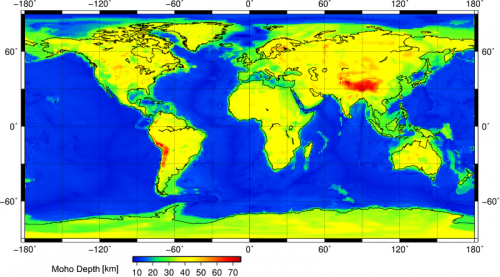December 5, 2013 report
Researchers propose foundering of lower island-arc crust explains continental Moho

(Phys.org) —Oliver Jagoutz of MIT and Mark Behn of Woods Hole Oceanographic Institution are suggesting in a paper they've had published in the journal Nature, that foundering of lower island-arc crust can explain characteristics of the origin of continental Moho.
It's been nearly a century since seismologist Andrija Mohorovicic discovered that seismic waves traveled faster through the crust at a deeper point—approximately 25 miles down below the continents. That changeover point has since been named the continental Moho, after him. Since that time, scientists have spent considerable effort trying to explain why it's there, but haven't had much luck because it's too deep to study directly. Adding to the mystery is that it doesn't exist beneath volcanic island chains that rise above tectonic plates. In this new effort Jagoutz and Behn offer what they believe is a reasonable explanation for what has been observed—it's all about foundering, they say.
Foundering is where something sinks in water—ships founder at sea for example. In this case, the foundering, the researchers say, occurs beneath the crust—molten material hardens as it cools leaving a gap between the crust and the mantle. Foundering occurs when material from the ceiling above, falls in the mantle below. The researchers describe it as a type of crystalline rain, falling into the mantle—and whether it happens or not depends on how much heat is present. When it does occur, eventually the gap is filled and the formation of a Moho is complete.
To come to these conclusions, the two researchers looked at data that describe rock samples found in Alaska and Pakistan—both have been proven to have made their way to the surface after formation some 25 miles down below, i.e. at the depth of continental Mohos—but only one showed evidence of having come from an actual Moho. The Pakistani rocks showed no sharp density contrast consistent with a Moho type boundary.
This can be explained, the two researchers say, by heat distribution far below the surface. When there is sufficient heat (such as is found near volcanic areas) there is foundering, leading to the development of a Moho—when there is not, there is no such development. Seismic data backs up their claim, they say, suggesting that foundering may be the long sought answer to the question of how Mohos form.
More information: Foundering of lower island-arc crust as an explanation for the origin of the continental Moho, Nature 504, 131–134 (05 December 2013) DOI: 10.1038/nature12758
Abstract
A long-standing theory for the genesis of continental crust is that it is formed in subduction zones. However, the observed seismic properties of lower crust and upper mantle in oceanic island arcs differ significantly from those in the continental crust4. Accordingly, significant modifications of lower arc crust must occur, if continental crust is indeed formed from island arcs. Here we investigate how the seismic characteristics of arc crust are transformed into those of the continental crust by calculating the density and seismic structure of two exposed sections of island arc (Kohistan and Talkeetna). The Kohistan crustal section is negatively buoyant with respect to the underlying depleted upper mantle at depths exceeding 40 kilometres and is characterized by a steady increase in seismic velocity similar to that observed in active arcs. In contrast, the lower Talkeetna crust is density sorted, preserving only relicts (about ten to a hundred metres thick) of rock with density exceeding that of the underlying mantle. Specifically, the foundering of the lower Talkeetna crust resulted in the replacement of dense mafic and ultramafic cumulates by residual upper mantle, producing a sharp seismic discontinuity at depths of around 38 to 42 kilometres, characteristic of the continental Mohorovičić discontinuity (the Moho). Dynamic calculations indicate that foundering is an episodic process that occurs in most arcs with a periodicity of half a million to five million years. Moreover, because foundering will continue after arc magmatism ceases, this process ultimately results in the formation of the continental Moho.
Journal information: Nature
© 2013 Phys.org




















